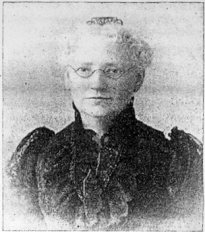
Biographical sketches on Martha Finley agree that she was born in Chillicothe, Ohio, in April, 1828, the daughter of Dr. James Brown Finley and his wife and first cousin, Maria Theresa Brown Finley, and that she lived a quiet life. In spite of this—or perhaps because of it—her biographers seem to have considerable trouble agreeing on much else about her life.
She was born either April 26 [1] or April 28 [2] and lived in Circleville, Ohio, until she was six [3] or eight [4], when the family moved to South Bend, Indiana.
Except for a year at school in Philadelphia, she lived in South Bend until 1853,
when she was twenty-five, [5] possibly teaching in Indiana schools from 1851-1853.[6] In 1853,
her parents [7] or father [8] died, and she moved either to Phoenixville,
Pennsylvania, to teach, [9] or to New York for a year. [10]

In 1854, she either moved to Philadelphia [11] or to an unspecified town in Pennsylvania,[12] to write for the Presbyterian Publishing Board.
In 1861, she may have taught in Phoenixville, Pennsylvania, and worked on Elsie Dinsmore [13] (which did not appear until 1867), or she may have begun Elsie Dinsmore "during the Civil War, when [she] was bedridden with a back ailment and dependent upon her stepbrother for support." [14] The project (but not necessarily her illness) lasted three-and-a-half years. [15]
All sources agree that Martha Finley eventually ended up in Elkton, Maryland, but when and how she arrived and settled are also matters for debate. She may have stayed with her aunt and sister in Bedford, Pennsylvania, from an unspecified date until 1872, then moved to Elkton sometime after, to live with her sisters and stepbrother,[16] before moving to her own home in Elkton, [17] or she may have purchased her home in Elkton in 1876,[18] or simply moved there in 1876. [19] She remained there writing successful girls' fiction until her death in 1909.
Martha Finley is best known for her Elsie Dinsmore series, melodramatic and sentimental fiction focusing on Elsie's trials and the solace offered her by her religious beliefs. Originally written under the pseudonym "Martha Farquharson" (Gaelic for "Finley"), the series lasted for 28 volumes, published over a period of 38 years. Much has been written about the series, discussing everything from its tear-soaked heroine and her relationship with her father to its enduring popularity during the 19th century. [20]
Elsie, however, was only a little over a quarter of Ms. Finley's total works. A second series, Mildred Keith, ran for seven volumes and chronicles the life of Mildred Keith and her family as well providing glimpses of Elsie Dinsmore's early years. Mildred is a slightly more realistic character than Elsie, with spunk and independence and without Elsie's perpetual penchant for tears and Biblical quotations.
Martha Finley also wrote more than fifty short books or pamphlets, primarily for children, which were published by the Presbyterian Board of Publication and/or the Presbyterian Publishing Committee. The majority of these appeared between 1856 and 1876 in series or as individual volumes. Their titles and publishers suggest that they, too, were didactic literature, with a strong emphasis on religion.
Much of Martha Finley's writing was quickly forgotten, but Elsie perservered for over seventy-five years. In 1945, the first 12 volumes were still in print in the United States and England and had sold over 5,000,000 million copies. It has only been in the last half-century that Elsie's popularity has faded.
Endnotes
1. National Cyclopedia of American Biography (1898; rpt. New York: James T. White & co., 1924), VIII[?], 267. Also American Authors 1600-1900: A Biographical Dictionary of American Literature, edited by Stanley J. Kunitz and Howard Haycraft (New York: H. W. Wilson Co., 1938), p. 272.
2. Janet E. Brown, The Saga of Elsie Dinsmore: A Study in Nineteenth Century Sensibility," University of Buffalo Studies, 17 (1945), 79.
3. American Authors, p. 272.
4. NCAB, p. 267; Brown, p. 79.
5. NCAB, p. 267; American Authors, p. 272. Brown does not mention Ms. Finley leaving South Bend.
6. American Authors, p. 272.
7. Brown, p. 79.
8. NCAB, p. 267.
9. Brown, p. 79.
10. NCAB, p. 267; American Authors, p. 272.
11. Brown, p. 79; American Authors, p. 272.
12. NCAB, p. 267.
13. NCAB, p. 267.
14. Brown, p. 79. "[S]he prayed for the ability to write a book which would augment her own slender income" (Brown, p. 79). Brown mentions the series "netted their author an estimated quarter of a million dollars" (p. 80).
15. Brown, p. 79.
16. Brown, p. 80. Brown does not mention whether this was the same stepbrother who had helped Finley when she was ill.
17. Brown, p. 80.
18. American Authors, p. 272.
19. NCAB, p. 267.
20 . Most notably by Brown, pp. 75-131. Other commentaries on Elsie include Agnes Repplier, "Little Pharisees in Fiction," Scribner's Magazine,
20 (December, 1896); Ruth Suckow, "Elsie
Dinsmore: A Study in Perfection" Bookman 66 (Oct. 1909); and
G. B. Stern, "Onward and Upward with the Arts—Elsie Reread," The New Yorker, March 14, 1936.
More recent studies are Jacqueline Jackson and Philip
Kendall, "What Makes a Bad Book Good: Elsie Dinsmore," Children's Literature
7 (1978); Pam Hardman, "Elsie Dinsmore and the Training of a Victorian Child,"
American Studies 29 (Fall 1988);
and Deidre Johnson, "Nancy Drew -- A Modern Elsie Dinsmore?"
The Lion and the Unicorn 18 (1994).
Another biographical sketch of Finley appeared in Ladies' Home Journal in 1896.
Click here to read the text of that article.
Biographical sources cited
American Authors 1600-1900: A Biographical Dictionary of American Literature. Edited by Stanley J. Kunitz and Howard Haycraft. New York: H. W. Wilson Co., 1938.
Brown, Janet E. "The Saga of Elsie Dinsmore: A Study in Nineteenth Century Sensibilities." University of Buffalo Studies 17 (1945), 75-131.
National Cyclopedia of American Biography. 1898; rpt. New York: James T. White &
co., 1924. Vol. VIII [?].
Return to main page
Copyright 1999-2000 by Deidre Johnson